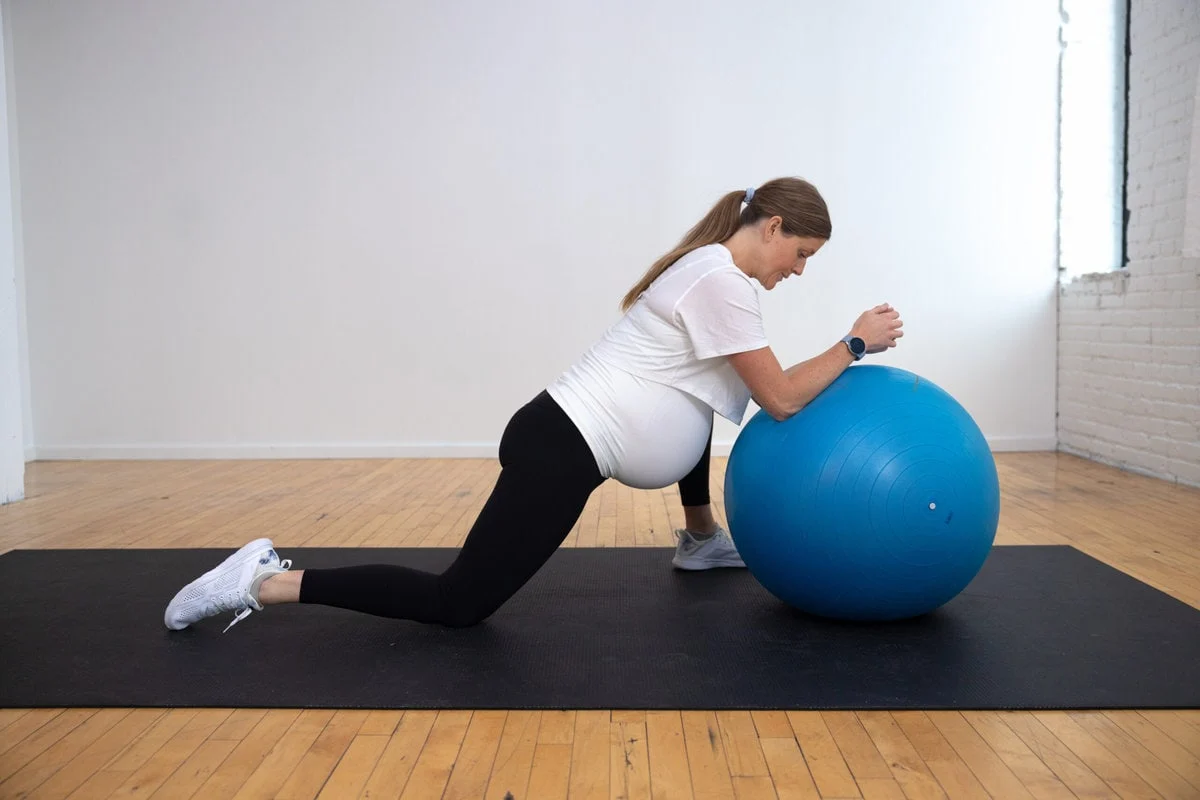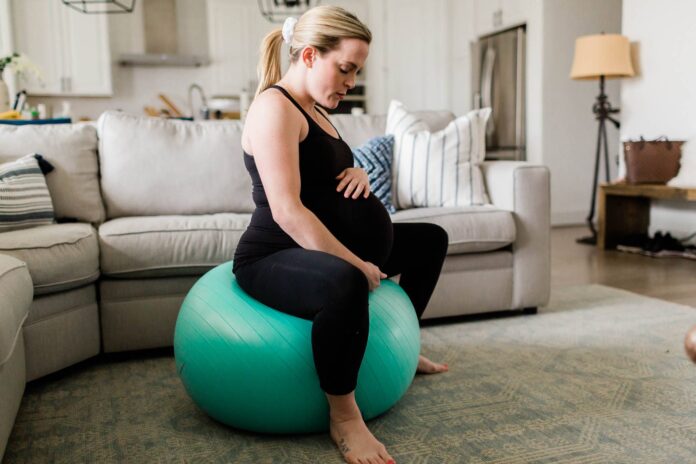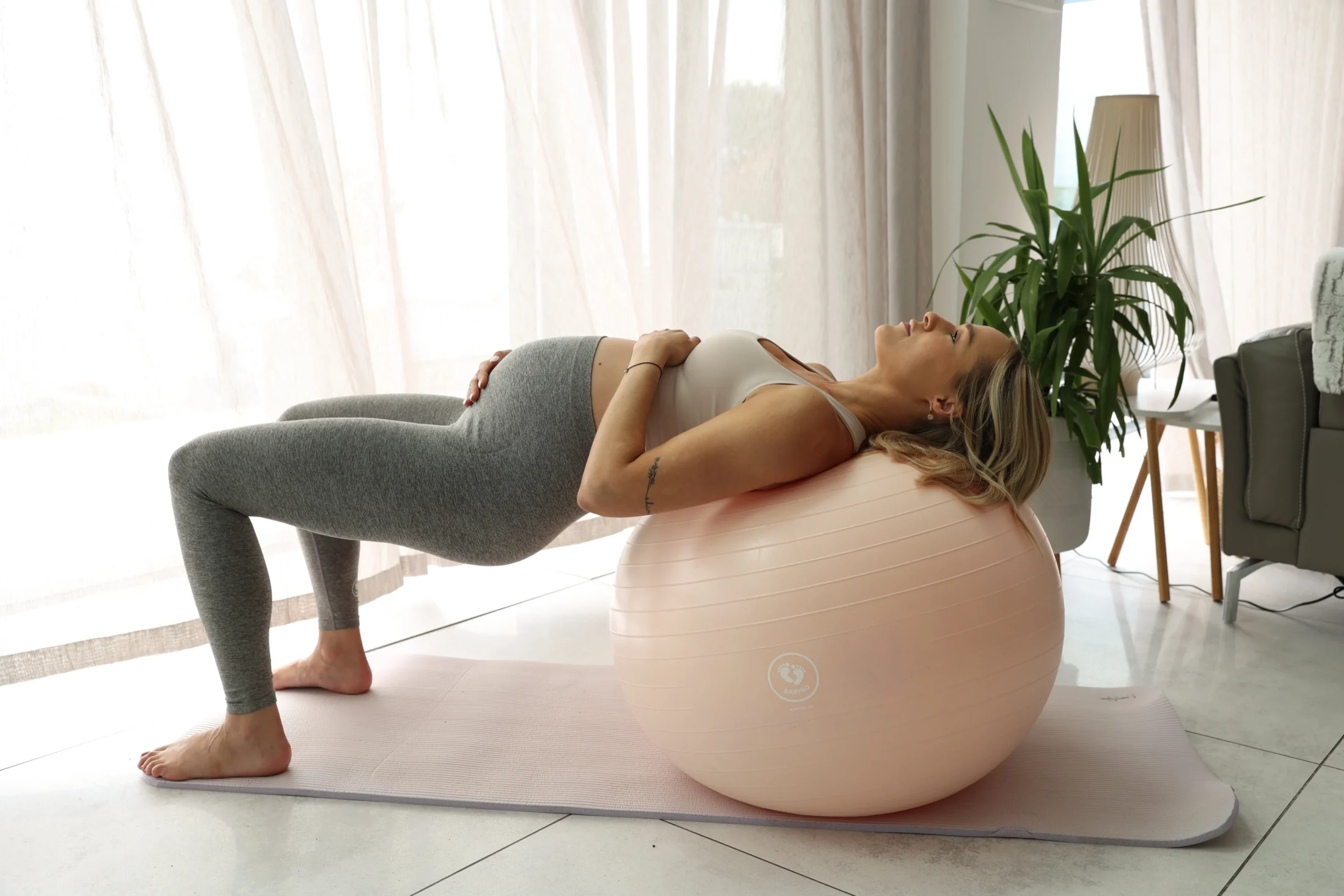Using a yoga ball during pregnancy can be a helpful and versatile tool for maintaining fitness and promoting overall well-being. Here’s a guide on the role of a yoga ball during pregnancy and how to select the correct size:
Role of a Yoga Ball During Pregnancy

1. Stability and Balance
The use of a yoga ball during pregnancy plays a crucial role in enhancing stability and balance by leveraging its inherently unstable surface. The dynamic nature of the ball compels engagement from the core muscles, fostering a heightened sense of balance and stability. This is particularly advantageous during pregnancy, a time when the body undergoes profound changes in its centre of gravity. As the baby grows and the body adapts, the distribution of weight shifts, impacting the equilibrium of the expectant mother. By incorporating the yoga ball into fitness routines, individuals can effectively target and strengthen the core muscles, aiding in the maintenance of balance and stability. This not only contributes to the prevention of falls and accidents but also promotes a sense of confidence and control over one’s body during a period of physical transformation. The utilisation of the yoga ball thus becomes an empowering tool for expectant mothers seeking to navigate the challenges of a shifting centre of gravity with increased poise and assurance.
2. Pelvic Floor Strengthening
Engaging in specific exercises on the yoga ball, such as pelvic tilts and circles, serves as an effective method for strengthening the pelvic floor muscles during pregnancy. These exercises target the muscles that play a crucial role in supporting the bladder, uterus, and bowels. Strengthening the pelvic floor is particularly beneficial for expectant mothers, as it can enhance muscle tone and flexibility, potentially easing the process of childbirth. By incorporating the yoga ball into a regular fitness routine, pregnant individuals can proactively contribute to the health and resilience of their pelvic floor muscles.
3. Comfort and Relief

The simple act of sitting on a yoga ball offers a welcome source of comfort and relief for expectant mothers dealing with back pain and discomfort associated with prolonged periods of sitting. Unlike traditional chairs, the yoga ball provides a supportive yet dynamic surface that encourages subtle movements and adjustments, promoting better posture and reducing strain on the lower back. This makes it an accessible and convenient option for relieving common discomforts experienced during pregnancy, fostering a more comfortable and adaptable sitting experience.
4. Labour and Birthing Aid
During labour, the yoga ball can become a valuable aid in easing contractions and facilitating comfortable positions. Many women find relief by bouncing on the ball or gently rocking back and forth, as these movements can help alleviate pressure and promote relaxation. The versatility of the yoga ball allows for various positions, providing expectant mothers with options to find what feels most soothing during the different stages of labour. Its use as a birthing aid aligns with a holistic approach to childbirth, offering both physical support and emotional comfort.
5. Gentle Exercise
Yoga ball exercises are inherently low-impact, making them a gentle and suitable option for pregnant women seeking to maintain fitness. The buoyancy and softness of the ball reduce the impact on joints and muscles, minimising the risk of strain or injury. Incorporating these exercises into a prenatal fitness routine allows expectant mothers to stay active and promote overall well-being without subjecting their bodies to excessive stress. The gentle nature of yoga ball exercises aligns with the unique needs of pregnancy, supporting physical health while prioritising the safety and comfort of both mother and baby.
Selecting the Correct Size
1. Height-Based Sizing
Choosing the right size for a yoga ball is crucial for maximising its effectiveness and ensuring a safe and comfortable experience, especially during pregnancy. Height-based sizing provides a convenient guideline for selecting the appropriate ball size tailored to individual body dimensions. For those under 5’4″, a 55 cm ball is recommended, while individuals between 5’4″ and 5’10” are advised to use a 65 cm ball. Individuals who are taller than 5’10” are recommended to choose a yoga ball with a diameter of 75 cm.
2. Testing the Size
To verify the suitability of the chosen yoga ball size, it’s essential to conduct a simple yet effective test. When sitting on the ball, the feet should rest flat on the floor, and the knees should form a comfortable 90-degree angle. Actively testing different sizes allows individuals to identify the one that promotes proper alignment and comfort, ensuring optimal support during exercises and activities.
3. Inflation Level
Achieving the correct inflation level is paramount for the stability and functionality of the yoga ball. Overinflation may result in instability, while underinflation can compromise the ball’s ability to provide proper support. Following the manufacturer’s inflation guidelines is crucial to strike the right balance. During pregnancy, slightly softer inflation might be considered for added comfort, accommodating the unique needs and comfort preferences of expectant mothers.
4. Durability and Weight Capacity
Selecting a yoga ball made of durable materials with an adequate weight capacity is fundamental for ensuring safety and longevity. The ball should withstand the stress of exercises and movements without the risk of puncture or failure. Checking the manufacturer’s specifications for weight capacity is essential to guarantee that the ball can adequately support the user’s weight during various fitness activities.
5. Anti-Burst Design
Opting for a yoga ball with an anti-burst feature adds a layer of safety. This design prevents the ball from rapidly deflating in the event of a puncture, reducing the risk of injury. The anti-burst feature enhances the overall reliability of the yoga ball, making it a safer option for pregnant women engaging in exercises and movements that involve dynamic weight shifts.
Conclusion

To conclude, before embarking on any fitness routine during pregnancy, it’s crucial to consult with a healthcare provider to ensure that the chosen exercises are safe for individual circumstances. For those new to using a yoga ball, seeking guidance from a certified prenatal fitness instructor or participating in a prenatal fitness class can provide valuable insights into proper techniques and exercises, ensuring a safe and effective fitness experience during pregnancy.







